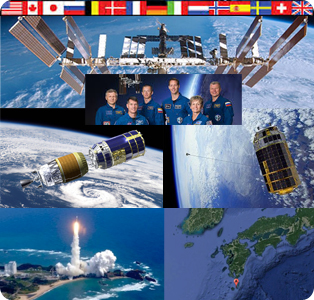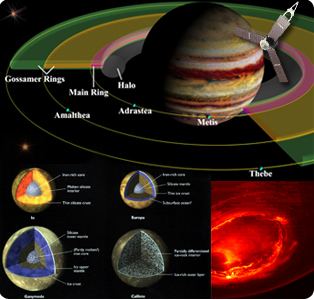Japan Set to Launch HTV 6 to ISS in Support of Human Spaceflight Operations
|
MONDAY Ongoing…
|

![]() = All times
= All times
for terrestrial events in local time unless noted.
![]() = All times for international terrestrial events in local time unless noted.
= All times for international terrestrial events in local time unless noted.
![]() = All times for space events, and…
= All times for space events, and…
![]() = All times for international space / astro events in Hawaii Standard Time unless noted. Add 10 hours to obtain UT (‘Universal Time;’ Greenwich, England).
= All times for international space / astro events in Hawaii Standard Time unless noted. Add 10 hours to obtain UT (‘Universal Time;’ Greenwich, England).
Weekly Planet Watch – Evening Planets: Venus (SW), Mars (SSW), Saturn (SW), Uranus (SE), Neptune (S); Morning Planets: Jupiter (ESE).
Juno Reaches Perijove, May Spend Extra 2 Years at Jupiter if Kept in Current Orbit
|
Continued from…
|
TUESDAY
![]() Dec 6 — Library of Congress Science, Technology and Business Division, Washington DC: Walking with the Last Men on the Moon: Revisiting the Apollo 17 Landing Site with the Lunar Reconnaissance Orbiter; Noah Petro, 11:30.
Dec 6 — Library of Congress Science, Technology and Business Division, Washington DC: Walking with the Last Men on the Moon: Revisiting the Apollo 17 Landing Site with the Lunar Reconnaissance Orbiter; Noah Petro, 11:30.
![]() Dec 6 — Wiltshire Astronomical Society, Melksham, United Kingdom: Odyssey Dramatic Presentation: Saturn – Lord of the Rings; at Pavillion Hall, 19:30.
Dec 6 — Wiltshire Astronomical Society, Melksham, United Kingdom: Odyssey Dramatic Presentation: Saturn – Lord of the Rings; at Pavillion Hall, 19:30.
![]() Dec 6 — SETI Institute, Mountain View CA: Lecture Crucible of Worlds: A System for Space Synthetic Biology Experiments; Aaron Berliner from Autodesk and UC Berkeley, 12:00.
Dec 6 — SETI Institute, Mountain View CA: Lecture Crucible of Worlds: A System for Space Synthetic Biology Experiments; Aaron Berliner from Autodesk and UC Berkeley, 12:00.
![]() Dec 6-7 — Defense Strategies Institute, Alexandria VA: 3rd Space Resiliency Summit; Mary Gates Learning Center.
Dec 6-7 — Defense Strategies Institute, Alexandria VA: 3rd Space Resiliency Summit; Mary Gates Learning Center.
![]() Dec 6 — Moon: 0.67° NNW of Neptune, 12:00; at first quarter, 23:03.
Dec 6 — Moon: 0.67° NNW of Neptune, 12:00; at first quarter, 23:03.
![]() Dec 6 — Apollo Asteroid 2016 WD7: Near-Earth Flyby (0.011 AU).
Dec 6 — Apollo Asteroid 2016 WD7: Near-Earth Flyby (0.011 AU).
![]() Dec 6 — Apollo Asteroid 2016 WH10: Near-Earth Flyby (0.015 AU).
Dec 6 — Apollo Asteroid 2016 WH10: Near-Earth Flyby (0.015 AU).
![]() Dec 6 — Apollo Asteroid 2016 TD18: Near-Earth Flyby (0.046 AU).
Dec 6 — Apollo Asteroid 2016 TD18: Near-Earth Flyby (0.046 AU).
![]() Dec 6 — Amor Asteroid 2016 UN36: Near-Earth Flyby (0.054 AU).
Dec 6 — Amor Asteroid 2016 UN36: Near-Earth Flyby (0.054 AU).
WEDNESDAY
![]() Dec 7 — Akatsuki, Venus Orbit: JAXA first successful planetary orbiter imaging Venus atmosphere, monitoring weather changes enters 2nd year at Venus today; launched May 11, 2001.
Dec 7 — Akatsuki, Venus Orbit: JAXA first successful planetary orbiter imaging Venus atmosphere, monitoring weather changes enters 2nd year at Venus today; launched May 11, 2001.
![]() Dec 7 — ISRO, Launch PSLV / Resourcesat 2A, Satish Dhawan Space Center, Sriharikota, India: India Polar Satellite Launch Vehicle, flying on the PSLV-C36 mission, to launch India Resourcesat 2A Earth observation satellite along with secondary payloads from India, Italy and Latvia.
Dec 7 — ISRO, Launch PSLV / Resourcesat 2A, Satish Dhawan Space Center, Sriharikota, India: India Polar Satellite Launch Vehicle, flying on the PSLV-C36 mission, to launch India Resourcesat 2A Earth observation satellite along with secondary payloads from India, Italy and Latvia.
![]() Dec 7 — United Launch Alliance, Launch Delta 4 / WGS 8, Cape Canaveral AFS FL: ULA Delta 4 rocket to launch USAF eighth Wideband Global SATCOM spacecraft.
Dec 7 — United Launch Alliance, Launch Delta 4 / WGS 8, Cape Canaveral AFS FL: ULA Delta 4 rocket to launch USAF eighth Wideband Global SATCOM spacecraft.
![]() Dec 7 — International Institute of Space Law, Washington DC: Galloway Symposium on Critical Issues of Space Law.
Dec 7 — International Institute of Space Law, Washington DC: Galloway Symposium on Critical Issues of Space Law.
![]() Dec 7 — Elliott School of International Affairs, Delegation of the European Union to the United States, U.S. State Department, Space Policy Institute at George Washington University, Washington DC: 2nd EU-US Space Policy Conference.
Dec 7 — Elliott School of International Affairs, Delegation of the European Union to the United States, U.S. State Department, Space Policy Institute at George Washington University, Washington DC: 2nd EU-US Space Policy Conference.
![]() Dec 7-9 — The National Academies, Irvine CA: Meeting: Large Strategic NASA Science Missions: Science Value and Role in a Balanced Portfolio.
Dec 7-9 — The National Academies, Irvine CA: Meeting: Large Strategic NASA Science Missions: Science Value and Role in a Balanced Portfolio.
![]() Dec 7-9 — Helmholtz Alliance for Astroparticle Physics (HAP), Cochem, Germany: Workshop: Monitoring the Non-thermal Universe.
Dec 7-9 — Helmholtz Alliance for Astroparticle Physics (HAP), Cochem, Germany: Workshop: Monitoring the Non-thermal Universe.
![]() Dec 7-9 — Netherlands Institute for Space Research (SRON), Gaia Science Alerts Working Group, Utrecht, Netherlands: 7th OPTICON Gaia Science Alerts Workshop.
Dec 7-9 — Netherlands Institute for Space Research (SRON), Gaia Science Alerts Working Group, Utrecht, Netherlands: 7th OPTICON Gaia Science Alerts Workshop.
![]() Dec 7 — Puppid Meteor Shower Peak: Appearing to radiate from constellations Puppis, Vela and Carina, up to 10 meteors per hour expected (some very bright) seen from southern hemisphere; followed closely by Monocerotid meteors which offer ~2 per hour at most.
Dec 7 — Puppid Meteor Shower Peak: Appearing to radiate from constellations Puppis, Vela and Carina, up to 10 meteors per hour expected (some very bright) seen from southern hemisphere; followed closely by Monocerotid meteors which offer ~2 per hour at most.
![]() Dec 7 — Amor Asteroid 2016 WV: Near-Earth Flyby (0.069 AU).
Dec 7 — Amor Asteroid 2016 WV: Near-Earth Flyby (0.069 AU).
![]() Dec 7 — Apollo Asteroid 2016 WD3: Near-Earth Flyby (0.070 AU).
Dec 7 — Apollo Asteroid 2016 WD3: Near-Earth Flyby (0.070 AU).
THURSDAY
![]() Dec 8 — Sutton Coldfield Civic Society, Sutton Coldfield, United Kingdom: Odyssey Dramatic Presentation: Lunatick Astronomy; at Holy Trinity Parish Church.
Dec 8 — Sutton Coldfield Civic Society, Sutton Coldfield, United Kingdom: Odyssey Dramatic Presentation: Lunatick Astronomy; at Holy Trinity Parish Church.
![]() Dec 8-11 — ICISE, Quy Nhon University, Tay Nguyen University, Buon Ma Thuot & Quy Nhon, Vietnam: Tropical School in Undergraduate Astronomy: Astronomical Observations.
Dec 8-11 — ICISE, Quy Nhon University, Tay Nguyen University, Buon Ma Thuot & Quy Nhon, Vietnam: Tropical School in Undergraduate Astronomy: Astronomical Observations.
FRIDAY
![]() Dec 9 — JAXA, Launch H-2B / HTV-6, Tanegashima Space Center, Japan: An uncrewed Japan H-2B rocket set to launch 6th H-2 transfer vehicle (Kounotori 6) to deliver supplies to ISS.
Dec 9 — JAXA, Launch H-2B / HTV-6, Tanegashima Space Center, Japan: An uncrewed Japan H-2B rocket set to launch 6th H-2 transfer vehicle (Kounotori 6) to deliver supplies to ISS.
![]() Dec 9 — Royal Astronomical Society, London, United Kingdom: Meeting: Frozen Worlds and Landscapes of our Solar System; Meeting: Radio Galaxies in the Local Universe.
Dec 9 — Royal Astronomical Society, London, United Kingdom: Meeting: Frozen Worlds and Landscapes of our Solar System; Meeting: Radio Galaxies in the Local Universe.
![]() Dec 9 — Caltech, Pasadena CA: Stargazing & Lecture Series: ALMA – A Revolutionary New View of the Cosmos; Nick Scoville of Caltech, 19:00.
Dec 9 — Caltech, Pasadena CA: Stargazing & Lecture Series: ALMA – A Revolutionary New View of the Cosmos; Nick Scoville of Caltech, 19:00.
![]() Dec 9 — NASA Planetary Science Division, Washington DC: Abstract Due for Planetary Science Vision 2050 Workshop; leading experts in solar system planetary science & space technologies to identify potential science goals and enabling technologies that can be implemented by the end of 2040s to support next phase of Solar System exploration; held Feb 27 – Mar 1, 2017.
Dec 9 — NASA Planetary Science Division, Washington DC: Abstract Due for Planetary Science Vision 2050 Workshop; leading experts in solar system planetary science & space technologies to identify potential science goals and enabling technologies that can be implemented by the end of 2040s to support next phase of Solar System exploration; held Feb 27 – Mar 1, 2017.
![]() Dec 9-11 — Faculty of Physics – University of Warsaw, Polish Society on Relativity, Warsaw, Poland: Gravitational Waves Conference: Mathematical, Computational, Astrophysical and Quantum Approaches.
Dec 9-11 — Faculty of Physics – University of Warsaw, Polish Society on Relativity, Warsaw, Poland: Gravitational Waves Conference: Mathematical, Computational, Astrophysical and Quantum Approaches.
![]() Dec 9 — Moon: 2.9° SSE of Uranus, 11:00.
Dec 9 — Moon: 2.9° SSE of Uranus, 11:00.
![]() Dec 9 — Aten Asteroid 1994 XL1: Near-Earth Flyby (0.092 AU).
Dec 9 — Aten Asteroid 1994 XL1: Near-Earth Flyby (0.092 AU).
SATURDAY
![]() Dec 10 — XMM-Newton, Very Eccentric Elliptical LEO: ESA craft studying X-ray emissions, star-forming regions, galaxy clusters, environment of supermassive black holes, mapping dark matter, enters 18th year in space today, launched 1999.
Dec 10 — XMM-Newton, Very Eccentric Elliptical LEO: ESA craft studying X-ray emissions, star-forming regions, galaxy clusters, environment of supermassive black holes, mapping dark matter, enters 18th year in space today, launched 1999.
![]() Dec 10 — Griffith Observatory, Los Angeles CA: Griffith Observatory Public Star Party; 14:00 – 22:00.
Dec 10 — Griffith Observatory, Los Angeles CA: Griffith Observatory Public Star Party; 14:00 – 22:00.
![]() Dec 10 — Saturn: At conjunction with Sun, 02:00.
Dec 10 — Saturn: At conjunction with Sun, 02:00.
![]() Dec 10 — Apollo Asteroid 2014 HM4: Near-Earth Flyby (0.060 AU).
Dec 10 — Apollo Asteroid 2014 HM4: Near-Earth Flyby (0.060 AU).
SUNDAY
![]() Dec 11 — Cassini, Saturn Orbit: Flyby of Prometheus (101,000-km altitude) and Pallene (95,000-km altitude).
Dec 11 — Cassini, Saturn Orbit: Flyby of Prometheus (101,000-km altitude) and Pallene (95,000-km altitude).
![]() Dec 11 — Juno, Jupiter Orbit: Spacecraft to perform close fly by of Jupiter today with science instruments on; craft may stay in 53.5-day orbit for mission duration which would extend mission by ~1.5 years without reducing science observations / goals.
Dec 11 — Juno, Jupiter Orbit: Spacecraft to perform close fly by of Jupiter today with science instruments on; craft may stay in 53.5-day orbit for mission duration which would extend mission by ~1.5 years without reducing science observations / goals.
![]() Dec 11 — CNSA, Launch Long March 3B / Fengyun 4A, Xichang Satellite Launch Center, China: Long March 3B rocket to launch Fengyun 4A geostationary weather satellite for China Meteorological Administration.
Dec 11 — CNSA, Launch Long March 3B / Fengyun 4A, Xichang Satellite Launch Center, China: Long March 3B rocket to launch Fengyun 4A geostationary weather satellite for China Meteorological Administration.
![]() Dec 11-16 — Rencontres du Vietnam, Vietnam National University, IAU, Qhy Nonh, Vietnam: Rencontres du Vietnam: Search for Life: From Early Earth to Exoplanets.
Dec 11-16 — Rencontres du Vietnam, Vietnam National University, IAU, Qhy Nonh, Vietnam: Rencontres du Vietnam: Search for Life: From Early Earth to Exoplanets.
![]() Dec 11-16 — University of Heidelberg – Institute for Theoretical Physics, Passo del Tonale, Italy: 10th TRR33 Winter School on Cosmology.
Dec 11-16 — University of Heidelberg – Institute for Theoretical Physics, Passo del Tonale, Italy: 10th TRR33 Winter School on Cosmology.

